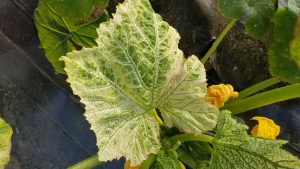 Every growing season, farmers prepare for the expected diseases. You plant at the appropriate time, buy varieties that have resistance or tolerance to various diseases, utilize fungicides that have protective properties to try to reduce the chance of developing problems, water in a timely manner, and grow your crop with a multitude of best management practices. One of the most frustrating things could be to encounter something that you never took into an account–the onset of a virus.
Every growing season, farmers prepare for the expected diseases. You plant at the appropriate time, buy varieties that have resistance or tolerance to various diseases, utilize fungicides that have protective properties to try to reduce the chance of developing problems, water in a timely manner, and grow your crop with a multitude of best management practices. One of the most frustrating things could be to encounter something that you never took into an account–the onset of a virus.
Unlike a bacteria or fungus, a virus has no chemical to control it. Seeds can come infected with the virus, or a virus can be introduced through a wound in the plant. A virus can affect a small portion of the plant through cell to cell movement, or a virus can become systemic and travel throughout the vascular system of the plant and wreak havoc. Some symptoms of systemic infection include the following:
- Malformations ‐stunting, twisting of the growing tips, leaf curling, leaf distortion,
- Epinasty– the unequal growth of two surfaces leading to curling of the whole leaf
- Enations–outgrowths from upper or lower surfaces of leaves
- Delayed senescence (Delayed senescence (plants remain vegetative)
- Mosaics-pattern of light and dark areas or streaks or stripes
- Stunting and Dwarfing
- Death of plant tissue (necrosis)
- Mottling or chlorosis of plant tissue
*Source of information: Dr. Jane Polston, Viruses that Infect Plants, UF Plant Pathologist
Sometimes when symptoms first start in a plant, instinct might lead one to believe that it is a nutrient issue. If a grower is questioning whether it is nutrients, disease, or virus, please contact your local Extension agent to help make a determination. Often agents have to send a representative plant sample off to the UF-NFREC Plant Pathology lab for diagnostics, but the lab will run a barrage of tests to determine the cause of the problem.
Recently, we had to submit a squash plant that was showing unusual symptoms. Although lab tests are ongoing, The sample tested positive for Potyvirus group. It tested negative for a number of virus problems, including the following commonly occurring viruses on squash: Cucumber Mosaic Virus, Papaya Ringspot Virus (formerly Watermelon Mosaic Virus I), Squash Mosaic Virus, Watermelon Mosaic Virus, and Zucchini Yellow Mosaic Virus). Potyviruses are aphid-transmitted and sometimes seed-transmitted.
What is the farmer to do? There are no controls for viruses. Since this is a potyvirus, reducing the chance of aphid transmission is important. Using reflective mulch may help to prevent aphid transmission of viruses. In greenhouse setting, removing and discarding infected plant material and controlling the aphids will greatly help control the disease.
Additional information about squash viruses
- Recommendations for Management of Whiteflies, Whitefly-Transmitted Viruses, and Insecticide Resistance for Production of Cucurbit Crops in Florida
- 2017 Florida Plant Disease Management Guide: Squash

 0
0

